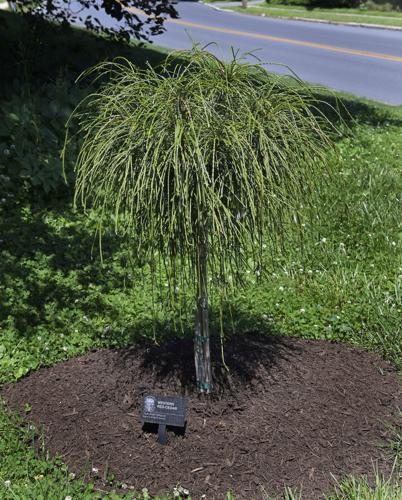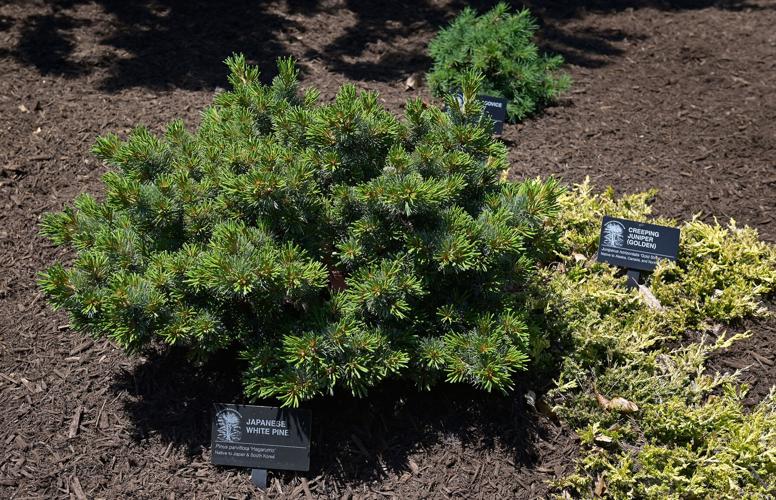The trees surrounding Wheatland tower overhead, yet in one corner, the plants can be crushed by the tiniest feet.
Here, in the dwarf conifer garden, a circle of twigs surrounds a 5-inch tall Silberkugel miniature Norway spruce.
“I am trying to protect it,” says Bob Davis, a board member at the Tanger Arboretum. “He’s a little guy and the kids will cut the corner and run right through.”
That fence will give this little tree space to grow. Young Norway spruces usually grow up to 3 feet in a year. The miniature version will grow less than an inch in the same time.
The arboretum on the grounds of LancasterHistory has about 150 different species of trees. The dwarf conifer garden has about the same amount packed into a small area. It’s the biggest collection of tiny trees in the area. Thanks to a donation from a conifer-loving gardener, the space has dozens of new itty-bitty plants.
Small plants are cute but also practical. When a plant tops out at a foot tall, there’s more space for variety.
“Not everybody can plant a tree like that in your back yard,” Davis says, pointing at a full-size Atlas Cedar, which can grow to 130 feet tall.
But a dwarf version fits in most spaces and sometimes won’t mind living in a container.
“A lot of these plants are nice for city landscapes,” says Jeff Hazlett, past president of the arboretum.
A Colorado spruce is one of the dwarf conifers in the garden at the Tanger Arboretum at Lancasterhistory on Tuesday, May 31, 2022.
Suzette WengerA tiny reference garden
The first tiny plants debuted at the 10-acre campus in 2015. Each plant has a label so visitors can learn more.
“The whole purpose is public education,” says Davis, who cares for the garden.
His work made the garden one of the American Conifer Society’s conifer reference gardens. There are 10 reference gardens throughout the northeast region but most only have a few, if any, dwarf conifers, says Michael Larkin, president of the society’s northeast region. He’s not aware of any other reference garden dedicated to small conifers and credits Davis for his work.
“What he’s created there, in my eyes, is pretty amazing,” says Larkin, who lives near Harrisburg. “I know all of the work it takes and all of the time it takes. Conifers aren’t as quite as busy or time-consuming but it’s still the right plant and the right conditions. And it still takes care and maintenance.”
For the conifers planted in the ground, they’re watered five to six times a year. The plants in containers need extra attention.
A western red cedar is one of the dwarf conifers in the garden at the Tanger Arboretum at Lancasterhistory on Tuesday, May 31, 2022.
Suzette WengerEvery conifer has a story
Every year, Davis adds up to 10 new plants to the collection to add variety and replace plants that don’t make it. He looks for variety in texture, shape and color.
The newest additions come from Walter Cullerton, former president of the northeast region of the American Conifer Society. Before he passed away last year, Cullerton offered the smallest specimens from his collection at his Bucks County home.
Tanger Arboretum's dwarf conifer garden open dawn to dusk [photos]
The Louise Arnold Tanger Arboretum sits on the campus of the LancasterHistory along North President Avenue.
In late 2015, an American Conifer Society was added to the arboretum.
The landscape houses the Dwarf Conifer Garden, holding 150 species of miniature and dwarf conifers that mimic their larger counterparts.
The garden is open from dawn to dusk and there is no admission fee.
Watch where you step at the dwarf conifer garden in Tanger Arboretum. The plants here are small.
- Suzette Wenger
A prostrate blue noble fir is one of the dwarf conifers in the garden at the Tanger Arboretum at Lancasterhistory on Tuesday, May 31, 2022.
- Suzette Wenger
A sawara cypress is one of the dwarf conifers in the garden at the Tanger Arboretum at Lancasterhistory on Tuesday, May 31, 2022.
- Suzette Wenger
A dwarf Jack pine is one of the dwarf conifers in the garden at the Tanger Arboretum at Lancasterhistory on Tuesday, May 31, 2022.
- Suzette Wenger
A Pocono red spruce is one of the dwarf conifers in the garden at the Tanger Arboretum at Lancasterhistory on Tuesday, May 31, 2022.
- Suzette Wenger
An Oriental spruce full of new shoots is one of the dwarf conifers in the garden at the Tanger Arboretum at Lancasterhistory on Tuesday, May 31, 2022.
- Suzette Wenger
A miniture Norway spruce is one of the dwarf conifers in the garden at the Tanger Arboretum at Lancasterhistory on Tuesday, May 31, 2022.
- Suzette Wenger
An Engelmann spruce is one of the dwarf conifers in the garden at the Tanger Arboretum at Lancasterhistory on Tuesday, May 31, 2022.
- Suzette Wenger
A golden creeping jumiper is one of the dwarf conifers in the garden at the Tanger Arboretum at Lancasterhistory on Tuesday, May 31, 2022.
- Suzette Wenger
A common juniper is one of the dwarf conifers in the garden at the Tanger Arboretum at Lancasterhistory on Tuesday, May 31, 2022.
- Suzette Wenger
A Norway spruce is one of the dwarf conifers in the garden at the Tanger Arboretum at Lancasterhistory on Tuesday, May 31, 2022.
- Suzette Wenger
A silberkugel miniture Norway spruce is one of the dwarf conifers in the garden at the Tanger Arboretum at Lancasterhistory on Tuesday, May 31, 2022.
- Suzette Wenger
A dwarf Scots pine is one of the dwarf conifers in the garden at the Tanger Arboretum at Lancasterhistory on Tuesday, May 31, 2022.
- Suzette Wenger
A manonyana holub arborvitae is one of the dwarf conifers in the garden at the Tanger Arboretum at Lancasterhistory on Tuesday, May 31, 2022.
- Suzette Wenger
A full-sized ginkgo grows next to the dwarf conifer garden in the Tanger Arboretum, where there is a dwarf ginko tree.
- Suzette Wenger
A blue note Swiss stone pine is one of the dwarf conifers in the garden at the Tanger Arboretum at Lancasterhistory on Tuesday, May 31, 2022.
- Suzette Wenger
A full-size Swiss stone pine grows next to several dwarf versions at Tanger Arboretum.
- Suzette Wenger
A machala hybrid spruce is one of the dwarf conifers in the garden at the Tanger Arboretum at Lancasterhistory on Tuesday, May 31, 2022.
- Suzette Wenger
A Japanese white pine is one of the dwarf conifers in the garden at the Tanger Arboretum at Lancasterhistory on Tuesday, May 31, 2022.
- Suzette Wenger
A miniature Norway spruce is one of the conifers grafted onto a straight trunk to make a standard. The different forms show how even these small plants can have some height, perhaps allowing room to plant more mini plants underneath.
- Suzette Wenger
A weeping golden Norway spruce is one of the dwarf conifers in the garden at the Tanger Arboretum at Lancasterhistory on Tuesday, May 31, 2022.
- Suzette Wenger
A dwarf hinoki cypress is one of the dwarf conifers in the garden at the Tanger Arboretum at Lancasterhistory on Tuesday, May 31, 2022.
- Suzette Wenger
An Agatka Mountain pine is one of the dwarf conifers in the garden at the Tanger Arboretum at Lancasterhistory on Tuesday, May 31, 2022.
- Suzette Wenger
A Franky Boy oriental arborvitae is one of the dwarf conifers in the garden at the Tanger Arboretum at Lancasterhistory on Tuesday, May 31, 2022.
- Suzette Wenger
A shoot from a Franky Boy oriental arborvitae is one of the dwarf conifers in the garden at the Tanger Arboretum at Lancasterhistory on Tuesday, May 31, 2022.
- Suzette Wenger
Bob Davis cares for the plants in the dwarf conifer garden. Jeff Hazlett (right) is a past president at Tanger Arboretum at Lancasterhistory.
- Suzette Wenger
A pygmaea English yew is one of the dwarf conifers in the garden at the Tanger Arboretum at Lancasterhistory on Tuesday, May 31, 2022.
- Suzette Wenger
A dwarf Norway spruce is one of the dwarf conifers in the garden at the Tanger Arboretum at Lancasterhistory on Tuesday, May 31, 2022.
- Suzette Wenger
A Japanese white pine and a creeping juniper (golden) grow in the dwarf conifers garden at Tanger Arboretum.
- Suzette Wenger
The dwarf conifer garden at the Tanger Arboretum at Lancasterhistory on Tuesday, May 31, 2022.
- Suzette Wenger
The dwarf conifer garden at Tanger Arboretum is the biggest collection of tiny trees in the area.
- Suzette Wenger
“Every conifer’s got a story behind it,” Davis says as he pointed out a few of the plants.
There’s a small golden Canadian hemlock. This tree can be found throughout eastern North America, but not in bright yellow.
“If you walk in the woods, you’ll have to walk a long, long, long time before you find one that color,” he says.
A san ginkgo in the garden at the Tanger Arboretum at Lancasterhistory on Tuesday, May 31, 2022.
Suzette WengerThere’s a Japanese white pine that has new growth in a rare pink color.
A Kohouts Icebreaker Korean fir has silver needles, as close to a white conifer that Davis has seen.
Each one of these tiny trees has a full-sized version. A few have the larger siblings next to the dwarf conifer garden. See if you can match the ginko trees, the cedar of Lebanon trees and the Swiss stone pines.
There also are six pairs with one plant growing in-ground and one plant growing taller, grafted onto a straight trunk to make a standard. The different forms show how even these small plants can have some height, perhaps allowing room to plant more mini plants underneath.
The plants here are all conifers, but there’s a wide variety. A Western red cedar has long tendrils that some visitors call Cousin It. A picola Japanese umbrella pine has clusters of shiny green needles that some touch to see if it’s plastic. A Wolterdingen Japanese larch has needles that turn yellow in the fall and then fall off, but it’s not dead. A prostrate blue noble fir has silvery blue needles that stand at attention but actually are quite soft.
For beginners, a Japanese white pine is a good plant to try, Davis says. They’re easy to grow, come in many different shapes and sizes and don’t have many pests.
Success! An email has been sent to with a link to confirm list signup.
Error! There was an error processing your request.




 ERIN NEGLEY | Staff Writer
ERIN NEGLEY | Staff Writer

































